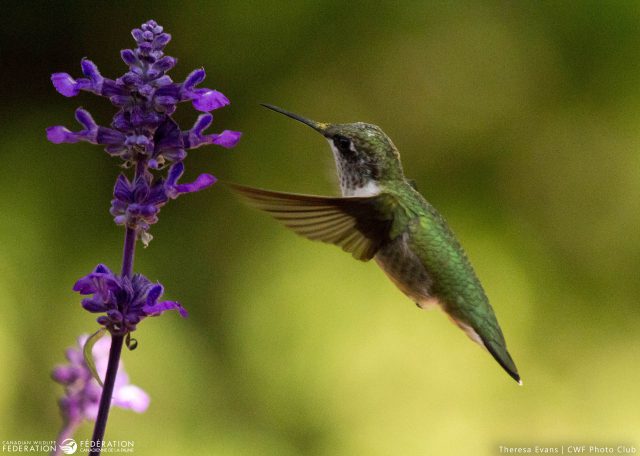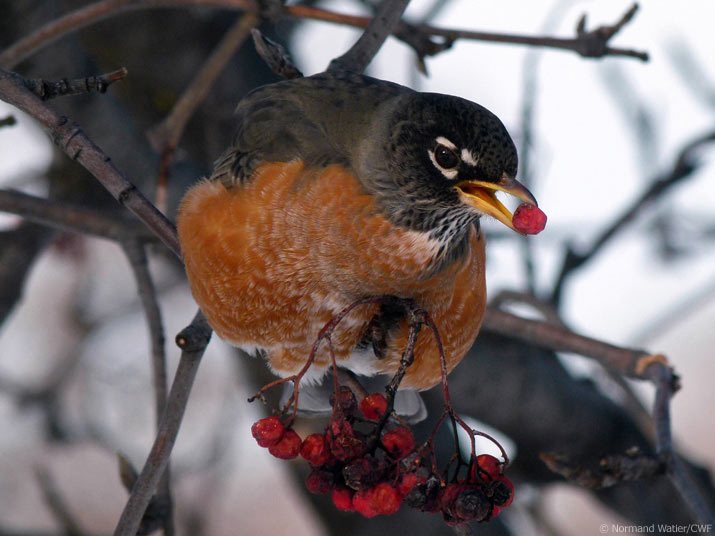Without Stopping at Your Birdfeeder
According to Statistics Canada, 25 per cent of 2017 Canadian households had bird feeders and bird houses in their yard. Is your home one of them? Bravo! But even if you don’t have a bird feeder in your backyard, there are plenty of ways that your favourite backyard birds will stay satiated.
Insects

Insects are like superfood for our feathered friends. Why? Well, they’re packed with protein, making them the ultimate snack for birds, especially when they’re busy raising their young or gearing up for migration.
Take chickadees, for example. When they’re not noshing at your feeder, they’re out hunting insects, particularly for their hungry fledglings. During the summer, they can gather over 1,000 small caterpillars in a single day to feed their young. And spiders? They’re a gold mine of taurine, a substance that develops the brain. So, chickadees are quick to bring plenty of these eight-legged critters home when their little ones are freshly hatched.
American Robins also love a tasty insect – you’ve probably seen plenty of robins hopping along lawns, scouring the ground for any movement from their favourite snacks – earthworms.
Plus, a whopping 80 per cent of cavity-nesting birds eat insects for breakfast, lunch and dinner. Pileated Woodpeckers, for example, love to chow down on carpenter ants, caterpillars, moths and beetles. They’ll hop up and down a rotted tree, pecking away at the wood, and nab as many insects as their barbed tongues can snatch up.
Nectar

While hummingbirds will certainly appreciate a sweet treat from a hummingbird feeder filled with sugary water, these incredible little birds are also drawn to gardens bursting with tubular, nectar-rich blooms. As they zip from one flower to the next, sipping on nectar, they’re also refueling for their migratory journeys ahead. Some of their favourite blooms include columbine, lilies, Penstemons, bergamot, bee balm, cardinal flower, honeysuckle and obedient plant.
Fruits

When the temperatures start to dip and insects take a hiatus, there’s something extra satisfying about sinking your beak into a juicy berry. It’s a feast many of our backyard birds, from thrushes to warblers look forward to!
The ultimate fruit aficionado of the avian world? Probably the Bohemian Waxwing. After all, they have fruit-bearing trees to thank for their bright plumage. Their bright red and yellow feathers are developed due to the carotenoid pigments in the fruit they eat. These stunning birds will happily munch on a variety of fruits from serviceberry to mountain ash, hawthorn and mulberry.
But Bohemian Waxwings aren’t the only ones with a penchant for fruit. Northern Cardinals will gladly join the party and gobble up all the fruit they can find from wild grape, mulberry, hackberry and blackberry plants. And don’t forget American Robins, who have a taste for chokecherries, hawthorn, dogwood, sumac and juniper berries.
Sap

Canada is home to four distinct species of sapsuckers: the Red-naped, Red-breasted, Yellow-bellied and Williamson’s – all of which adore the taste of tree sap. Their handiwork….errr…billwork….is hard to miss. These little guys will make neat rows of round holes along tree trunks in search of sap. They drill deep into tree trunks, inserting their bills in anticipation of the sweet reward of sap. And their tongues help them lap up the sticky sap as they’re equipped with hair-like tips. And when they strike gold, oh boy, do they go wild! After all, sap can contain over 10 per cent sugar. There are thousands of species of trees and other plants that they’ll tap for sap but their favourites are birch and maple. Even hummingbirds might stop by for a sip of liquid gold!



4 comments
The ‘down side’ (depending on the viewer) to backyard feeders is also their ability to attract non-seedeaters, namely hawks; just had to move a dead Blue Jay that hit a window at full speed, sounded like a baseball, they usually do that in panic mode trying to avoid the predator. The experienced hawks will grab a bird stunned by the window. I’ve got nothing against hawks, or owls. But some ‘sentimental’ bird seed providers might be upset; get used to it. Feral, or ‘outdoor housecats’ are a different story, here, out in the rural residences most folks have dogs, and guns, so the cats are not that much of a problem. We also have ‘resident’ coyotes and fishers; they like cats. Cheers.
We have a vertical feeder in our backyard for several years now. We fill it with good feed and top it up at intervals. It attracts a variety of birds , some eat directly form the feeder , others pick up fallen seeds. I make videos of birds behaviour at feeder and also during my walks record their life at ponds. Then I post them at my channel youtube.com/@dineshsikand with the aim to spread awareness about birds.
I also write articles about nature and birds at my website metanahat.org
We had a bird feeder this year, and enjoyed many different varieties of birds coming and going. The downside was it also attracted rats! We tried all kinds of deterrents, as we love the bird feeder! But with all the seed on the ground underneath the feeder, it was a feast for the rodents who came from out of the blue. We had to stop using the feeder, and miss it! Any suggestions?
Hi Arlene!
While ground feeders like juncos come to eat fallen seed, you can minimize what falls to the ground by attaching a seed tray to the bottom of your feeder or one that hangs below it. I have even seen a feeder tray that sits on the ground but slightly raised although if you used that (or landscape fabric) then you would want to bring it in before nightfall which might be too fiddly. You can also minimize what falls to the ground by having just one type of seed such as sunflower seeds or nyjer seeds.